One of the lesser known parts of the body that light therapy studies have examined is the muscles. Human muscle tissue has highly specialised systems for energy production, needing to be able to provide energy for both long periods of low consumption and short periods of intense consumption. Research in this area has accelerated dramatically in the last couple of years, with dozens of new high quality studies every month. Red and infrared light have been studied intensively for a variety of ailments and conditions, from joint pain to wound healing, possibly because the cellular effects are theorised to work on a foundational energetic level. So if light penetrates down into muscle tissue, can it exert beneficial effects there? In this article we will examine how light interacts with these systems and what benefits it may bring, if any.
Contents
Light-Muscle Interaction
Muscle Light Therapy Benefits
Hypertrophy / Size
Improved Strength
Reduced Soreness
Faster Healing
Ideal type of light
Summary
Recommended Products
References
Medical & Healthcare Disclaimer The information contained in this article is not intended or implicitly suggested to be an alternative for professional diagnoses, or profesionally recommended treatments & medical advice. Absolutely all of the content, including the article text itself, images, comments and other information, contained on this web page is for non-specific information purposes only. We strongly suggest that one should never ignore professional health/medical advice and we strongly suggest that one must not delay seeking a professionally recommended medical treatment because of information attained via reading this article/website. The products sold or recommended on this web site are absolutely not for the diagnosis, prevention, monitoring, treatment or alleviation of any specific disease, injury or disability.
Light might interact with muscle function, but how?
To understand how light might affect muscle tissue, we need to first understand how muscle tissue actually functions. Energy is necessary for life in every cell of every species we currently know of. This fact of life is more obviously apparent in muscle tissue, from a mechanical perspective, than any other type of tissue. Since muscles are involved in movement, they must be generating and using energy, or they wouldn’t move. Anything that helps with this fundamental energy production will be valuable.
- The light therapy mechanism
Light therapy has a well-known mechanism in any nearly any cell of the body with a mitochondrion (mitochondria being the organelles responsible for energy production). You can look into Cytochrome C Oxidase and Nitric Oxide to learn more of the specifics here, but basically the hypothesis is that both red and near-infrared light help our mitochondria to complete the process of respiration, giving more CO2 and ATP (energy). This would in theory apply in pretty much any cell of body, besides those lacking mitochondria such as red blood cells.
- The muscle-energy connection
One of the key characteristics of muscle cells is that they are exceptionally abundant in mitochondria, needing them to fulfil the high energy demands. This applies to skeletal muscle, cardiac muscle, and smooth muscle tissue like you would find in internal organs. The density of mitochondria in muscle tissue varies between species and parts of the body, but they all need a high degree of energy to function. The rich presence overall suggests why light therapy researchers are interested in the application of targeting muscles, even more so than other tissues.
- Muscle stem cells – growth & repair enhanced by light?
Myosatellite cells, a type of muscle stem cell involved in growth and repair, are also a key potential target of light therapy1,5, perhaps even the main target that gives long term effects. These satellite cells become active in response to strain (such as from mechanical movement like exercise or from injury) – a process that could be enhanced by light therapy9. Like stem cells in any location of the body, these satellite cells are essentially the precursors to normal muscle cells. They usually exist in a relaxed, inactive state, but will turn into other stem cells or turn into fully functional muscle cells as part of the healing process, in response to injury or exercise trauma. Recent research points to mitochondrial energy production within stem cells as the primary regulator of their fate6, essentially determining their ‘programming’ as well as their speed and efficiency. Since the hypothesis behind light therapy is that it might be a potent promoter of mitochondrial function, a clear mechanism exists to explain how light could maybe improve our muscle growth and repair via stem cells.
- Inflammation
Inflammation is a typical feature associated with muscle damage or stress. Some researchers think that light might help (if used appropriately) to reduce the severity of the inflammation3 (by increasing levels of CO2 – which then goes on to inhibit inflammatory cytokines/prostaglandins), thus allowing more efficient repair without scarring/fibrosis5.
Light therapy may or may not also help muscles indirectly by:Considered by some as the master regulatory hormone of the body, thyroid hormones are involved in cellular energy production in a big way. As mentioned above energy production is essential for both muscular performance and recovery. Studies have been done with (near)infrared light on the thyroid gland with the aim of seeing whether it can help normalise thyroid hormone levels, thus potentially helping muscle performance downstream. You can read more about thyroid light therapy here.
- Thyroid regulation
Better sleep is one of the most often reported effects of red light therapy, with several studies now showing evidence to support the common claim. As bodybuilders and athletes will testify to, good deep sleep is one of the most important parts of recovery, so any improvement here will help muscle function and healing.
- Sleep improvement
Some researchers think, and some animal studies have shown, that for men, red light can be used directly in the vicinity of the testes to potentially improve levels of the hormone testosterone. This hormone is well established in endocrinology as directly useful in boosting muscle strength, size and performance. We have a whole blog post on this topic here.
- Testosterone boost
The potential benefits to muscle function from light therapy
Essentially anyone that uses their muscles, or has a problem using their muscles, has been studied in terms of light therapy – athletes10,11,12,16,18, people with injuries and muscular disorders, bodybuilders20, and even just regular people exercising to stay in shape2,17. The same applies to pretty much any animal too, such as horses and dogs, whether involved in competitive racing or otherwise. Below are some of the effects studied in relation to light therapy on muscles:
-
Hypertrophy
The increase in size of muscles as a result of exercise (known as hypertrophy) has been studied in conjunction with light therapy, with interesting results2,14. In the context of muscle tissue, hypertrophy is part of an adaptive response that helps the tissue to generate more force with less fatigue. The physical appearance of long term gains in muscle size is highly sought after by bodybuilders and anyone trying to improve their shape/physique.
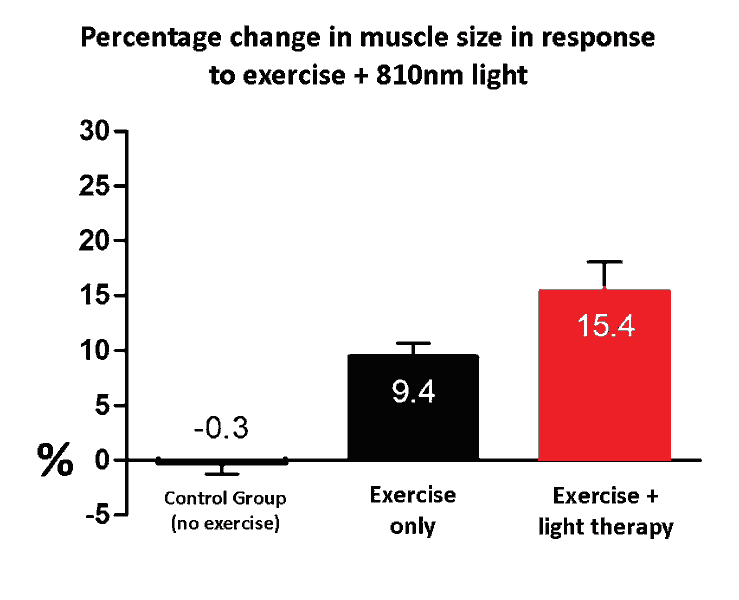
There is interesting evidence in some limited studies that using appropriate forms of near-infrared light before weight training potentially improves hypertrophy and muscle size gains compared to doing the same weight training exercises without any light. In the limited studies referenced above, specifically a group of untrained people, weight training with light therapy was associated with a doubling in muscle size gains over a period of 8 weeks, compared to doing the same exercise without any light therapy. This makes light therapy a potentially interesting tool for personal trainers10, or for elite athletes exercising alone11,12,16,18, or even just for regular people especially after a period of being sedentary2, potentially aiding your first few month’s progress, and being an aid in the long term too. Although this specific study was done on untrained individuals, there is reason to believe it will be effective for even well trained athletes10,11,18, maybe adding an edge to exercise results.
-
Strength – get stronger with light therapy?
Briefly mentioned above, light could interact with Myosatellite cells and regular muscle cells by potentially improving energy production. This would in theory give an immediate increase in strength and endurance through the regular muscle cells12,13,14,20, but also a long term increase through the myosatellite cells (relative to exercising without any complimentary light therapy)4.
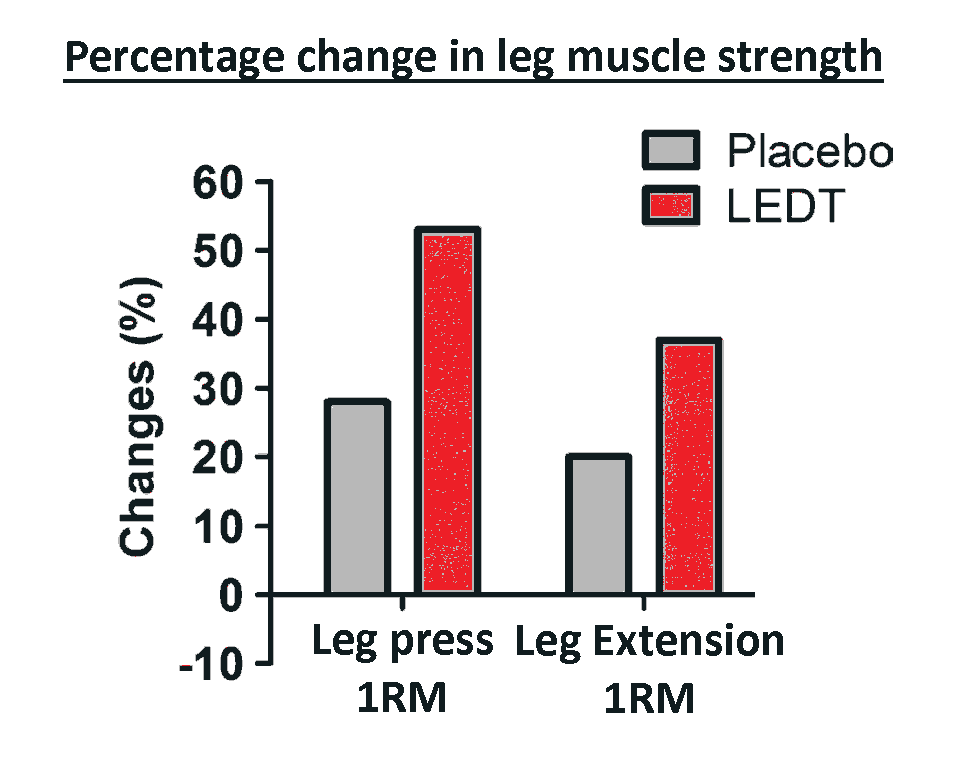
The studies looking at this tend to examine peak torque – the maximum force generated by a specific movement – and how this changes over time. Just like with hypertrophy, or to some extent because of hypertrophy, light therapy in conjunction with exercise, in these studies, clearly improved the gains in strength compared to exercise alone2. The gains have been significant across a wide range of studies, so much so that international regulatory authorities for sports are considering whether light therapy should even be permitted10.
-
Reduce DOMS/soreness with light therapy?
Several studies on muscle light therapy now point to the potential reduction, and quicker resolution, of delayed onset muscle soreness4,14 – the uncomfortable, yet sometimes satisfying, feeling you get in muscles the day after a tough workout. DOMS is thought to be caused by microtrauma to muscle fibers and is characterised on a cellular level by a rapid influx of calcium into the cell (amongst other things), which inhibits respiration. The displaced calcium entering the muscle cells can lead to damage and inflammation, hence the painful/sore feeling.
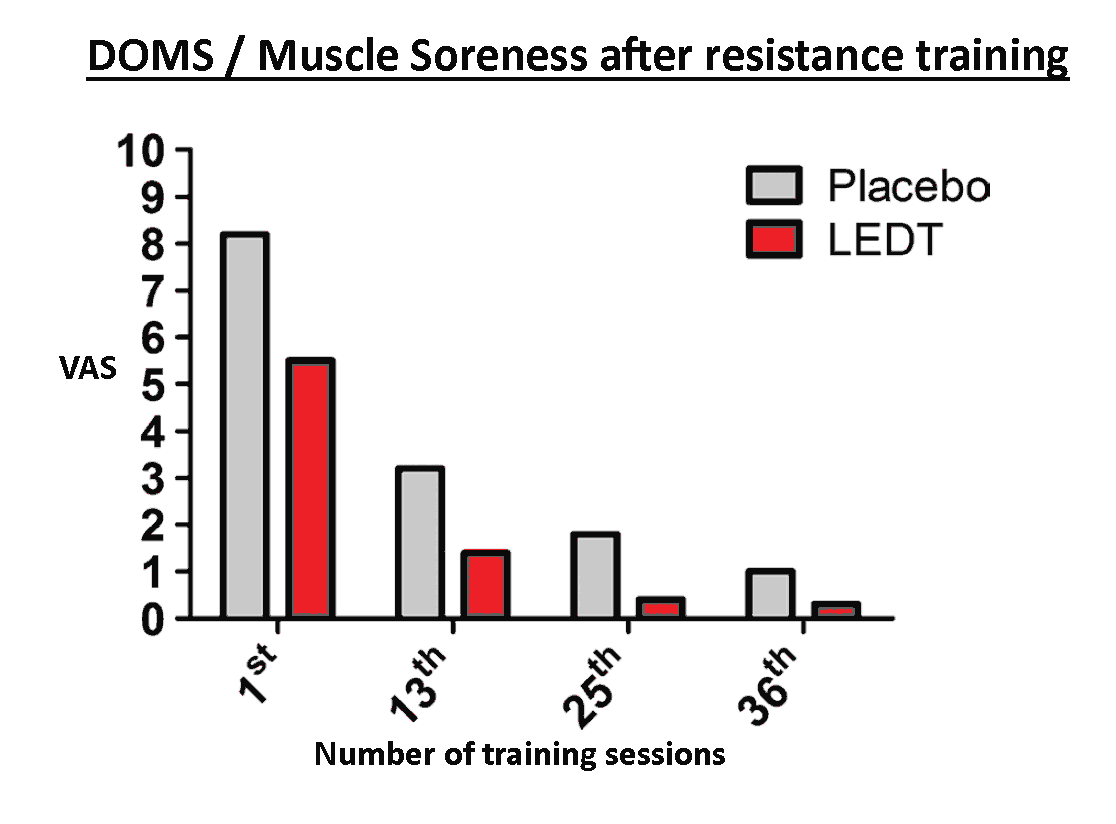
The calcium needs to be transported out of the cell again for recovery to proceed, and the cell needs ATP (energy) to do this. Fortunately the hypothesis explaining light therapy is that it potentially speeds up production of ATP (not to mention helping us to produce CO2 which reduces inflammation), and would thereby perhaps speed up the whole muscle recovery process7,8,9, which would in theory reduce both the severity of DOMS and the length of time until full recovery.
-
Improve injury/strain recovery with light?
Various studies point to the potentially positive effects of appropriately used light on post-injury recovery3,4,7,9. One risk of muscle injuries in general is the formation of fibrosis or scar tissue. Just as we get scars on the skin as a result of damage, we can also get them inside the muscles as the inflammatory response causes a spike in collagen formation. Light therapy may help to prevent that scarring5. When scar tissue forms in muscles, this permanently alters the function and mechanical properties of the muscle, leading to reduction in mobility/strength, long term pain, perhaps ending an athlete’s career or even disability in extreme cases. Resolving the injury as quickly as possible with as little inflammation as possible is crucial. Light therapy could be effective here for several reasons – as mentioned above it seems to be useful in reducing the acute inflammatory response, but also in kick starting and supporting the key processes of the muscle recovery process on a cellular level. Indeed this healing effect found in some studies on light therapy is apparent on not just muscle injuries, but also studied on wounds anywhere on the body, such as the skin but even brain trauma and broken bones.
Ideal light for muscle light therapy
There are several factors to consider to ensure that a light device is suitable for muscle light therapy.
- Infrared penetrates more than red
Perhaps the most obvious barrier to successful light therapy on muscles is actually getting the light down into the muscles. The majority of light applied to the body is absorbed in the skin, making treatment of deeper tissue problematic. Fortunately, we know that the infrared light therapy wavelengths between about 700-900nm penetrate much better than other wavelengths, including the red wavelengths at 600-700nm. This makes near-infrared light by far the most chosen wavelength range in studies muscle treatment. This doesn’t include any other form of infrared light, such as the mid-infrared or the far-infrared heat, neither of which are at all suitable. Even the near-infrared over 900nm is not really suitable, since it is progressively blocked by water in skin cells. Red light is still studied for this purpose, but will need a much higher application dose compared with an equal dose of infrared. Red light around 660-670nm is actually used in a large amount of studies on the topic, referenced below, especially in smaller animals like rodents, where penetration is less of an issue due to their tiny size. It still gives interesting results. 760-780nm is used in quite a few studies too, showing equally good effects. Most of the studies seem to indicate light around 810-830nm as the most chosen range17,18,19, especially in larger animals like humans/horses.
- Higher power density / high dose required
Even using the most penetrative types of near-infrared light at about 740-830nm, most of the energy is still absorbed by the skin and first layers of tissue (albeit a lower percentage than other wavelengths). So once you have ensured your light device has the suitable wavelengths, you need to ensure the right power. A low light intensity of even the most ideal wavelength of light isn’t going to do much good. In terms of light strength, below 50mW/cm² is definitely too weak for muscle depth penetration in humans. 200mW/cm² or more is popular in studies since it would provide sufficient energy penetration in reasonable time frames2,15. Doses of 100J/cm² or more, even up to 700J/cm², are studied for penetrating into deeper muscles with sufficient energy over time. If you want to know more about light therapy dosing, see this post here.
- Before or after exercise?
Once you have a light device with the correct wavelengths and enough power output, you need to figure out the best time to apply the dose. Studies at the moment indicate superior results when light is used before exercise4,11,15. This is also the conclusion is several literature reviews and meta-analyses on the subject. Using light therapy this way may potentially improve not only exercise performance (strength, speed, endurance) but also muscle recovery post-exercise. It makes sense that using it this way may also reduce the chance of injury. Using light after exercise is still potentially effective for recovery however, and much better than no light at all. Even using light several hours after exercise could be helpful. It could be that using light on the target muscles both before and after exercise is the best method, although this protocol has not been thoroughly compared to other protocols.
- Which light specifically?
All of the studies on the topic of muscle light therapy, and indeed the light therapy field in general, use either LEDs or lasers, both of which seem to be equally useful, with minor variations in parameters. This type of energy efficient, heat free, and specific wavelength lighting technology is required for muscle light therapy for various reasons. As the muscles are deep within the body, high doses of light must be applied to the skin in order for a reasonable dose to reach the actual muscle tissue. If a less specific lighting technology such as heat lamps, ‘infrared bulbs’, incandescents and other broad spectrum lights are used for the same purpose, a truly ridiculous amount of energy would have to be applied to skin to ensure the muscles receive a good dose, resulting in severe overexposure. Using these types of lights at a range that gives a good power density of the penetrative 700-850nm wavelengths would also burn the skin almost immediately.
Summary
- Light therapy is studied for muscles in a variety of ways
- Exercise recovery, injury recovery, muscle strength/endurance, hypertrophy, pain reduction and more.
- Red and near-infrared light (600 – 900nm wavelengths) are studied for and may help muscle cells and muscle stem cells by potentially improving energy production, reducing inflammation and speeding healing.
- Near-infrared (at 740-830nm wavelengths) is the most penetrative range into biological tissue.
- In theory requires a high power density of light (200mW/cm² or more) to achieve the penetration in bigger muscles.
- LEDs and lasers are the only currently viable, studied devices. Heat lamp light does not penetrate to muscles in sufficient density.
- Light therapy seems best used BEFORE exercise to maximise results, rather than after, according to current information.
Recommended light for Muscle Light Therapy
References
- Low-level laser (light) therapy (LLLT) on muscle tissue: performance, fatigue and repair benefited by the power of light. Cleber Ferraresi et al. 2012
- Effect of low-level laser therapy on muscle adaptation to knee extensor eccentric training. Baroni BM et al. 2015
- The low-level laser therapy on muscle injury recovery: literature review. Daniel Rodrigues dos Santos et al. 2010
- Does Phototherapy Enhance Skeletal Muscle Contractile Function and Postexercise Recovery? A Systematic Review. Paul A Borsa et al. 2013
- Low-level laser therapy (808 nm) contributes to muscle regeneration and prevents fibrosis in rat tibialis anterior muscle after cryolesion. Assis L et al. 2013
- Mitophagy-driven mitochondrial rejuvenation regulates stem cell fate. Vazquez-Martin A et al. 2016
- Red and Infrared Low-Level Laser Therapy Prior to Injury with or without Administration after Injury Modulate Oxidative Stress during the Muscle Repair Process. Ribeiro BG et al. 2016
- Effects of low-level laser therapy on ROS homeostasis and expression of IGF-1 and TGF-β1 in skeletal muscle during the repair process. Luo L et al. 2013
- Effects of low-level laser therapy on skeletal muscle repair: a systematic review. Alves AN et al. 2014
- Photobiomodulation in human muscle tissue: an advantage in sports performance? Ferraresi C et al. 2016
- Muscular pre-conditioning using light-emitting diode therapy (LEDT) for high-intensity exercise: a randomized double-blind placebo-controlled trial with a single elite runner. Ferraresi C et al. 2015
- Photobiomodulation Therapy Improves Performance and Accelerates Recovery of High-Level Rugby Players in Field Test: A Randomized, Crossover, Double-Blind, Placebo-Controlled Clinical Study. Pinto HD et al. 2016
- Light-emitting diode therapy in exercise-trained mice increases muscle performance, cytochrome c oxidase activity, ATP and cell proliferation. Ferraresi C et al. 2016
- Effects of Light-Emitting Diode Therapy on Muscle Hypertrophy, Gene Expression, Performance, Damage, and Delayed-Onset Muscle Soreness: Case-control Study with a Pair of Identical Twins. Ferraresi C et al. 2016
- Effect of phototherapy (low-level laser therapy and light-emitting diode therapy) on exercise performance and markers of exercise recovery: a systematic review with meta-analysis. Leal-Junior EC et al. 2015
- Comparison between cold water immersion therapy (CWIT) and light emitting diode therapy (LEDT) in short-term skeletal muscle recovery after high-intensity exercise in athletes–preliminary results. Leal Junior EC et al. 2011
- Effect of 830 nm low-level laser therapy in exercise-induced skeletal muscle fatigue in humans. Leal Junior EC et al. 2009
- Effect of 830 nm low-level laser therapy applied before high-intensity exercises on skeletal muscle recovery in athletes. Leal Junior EC et al. 2009
- 830 nm light-emitting diode (led) phototherapy significantly reduced return-to-play in injured university athletes: a pilot study. Foley J et al. 2016
- Near-infrared light therapy to attenuate strength loss after strenuous resistance exercise. Larkin-Kaiser KA et al. 2015

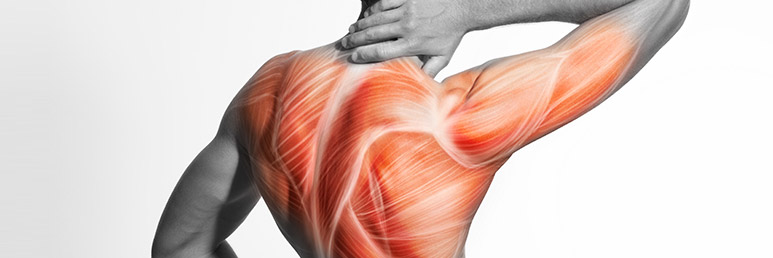
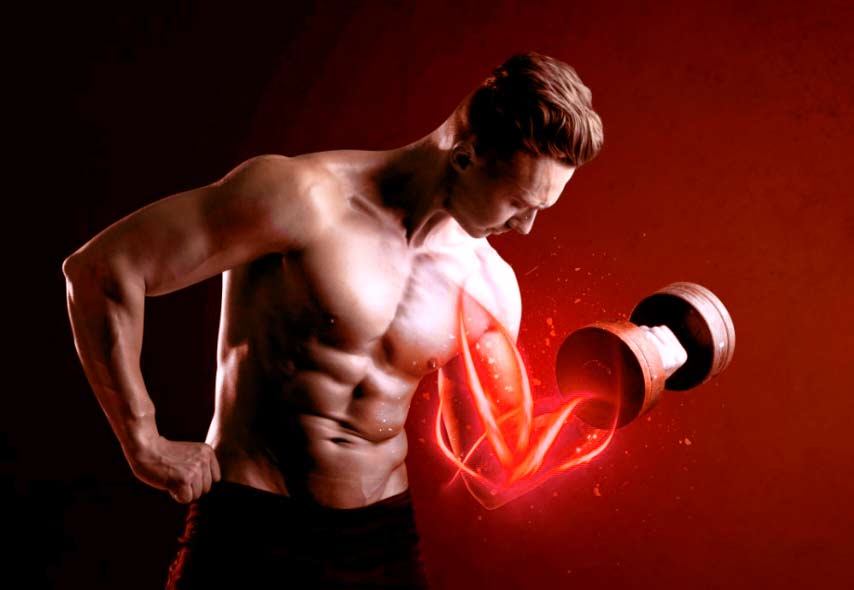

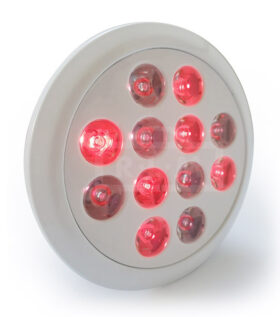
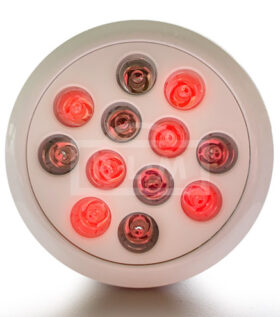
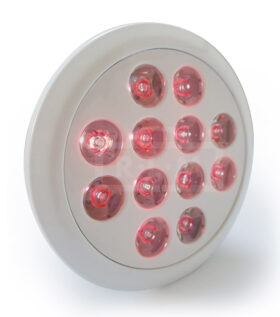
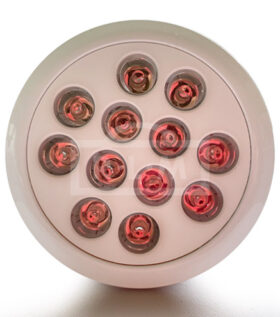
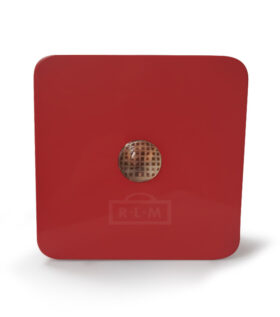
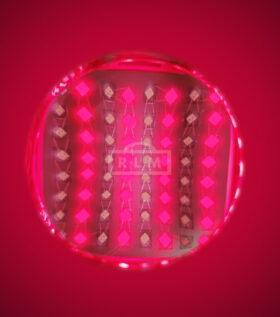
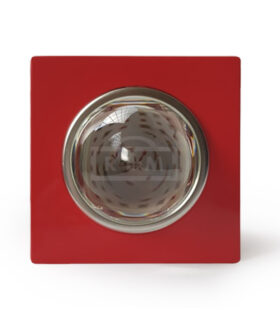
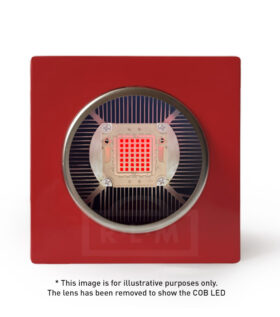
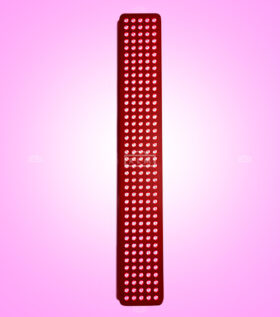
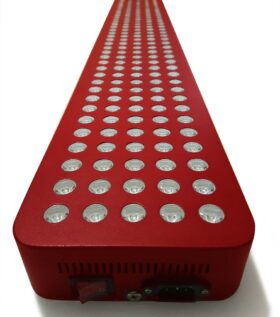
Which light would you recommend for long term muscle pain in the calf leg muscle?
https://redlightman.com/product/infrared-830-device/
Red light penetration is less deep. Infrared penetration is deeper. Many devices use both together for greater effects.
I miss your blog posts!
Also, any Vitamin D lamps/bulbs you can recommend?
Unfortunately not. We have not found any good bulb types for the UVB wavelengths. You can get 311nm narrowband UVB bulbs, but I think they will be minimally effective and light around 300nm will be much better.
Thanks Joe. Any update on when the Bodylights will be back in stock?
I have a 3 cm tear in the abductor from 6 months ago, start red light therapy twice a day for 10 mins. How long before I see results? Any other suggestions? Would love to get back to playing hockey. Thanks.
It is thought that light therapy just speeds up your normal healing response. So for example, if the tear would take 4 months to heal normally, it might only take 2-3 months with light therapy treatments.
What about the Full Body Enhancement machine… Any thoughts?
“Near-infrared (at 760-830nm wavelengths) is the most effective range, due to the superior penetration.”
” Still requires a high power density of light (200mW/cm² or more) to achieve the penetration in bigger muscles.”
Some questions i have. After seeing interviews from Dr. Hamblin he mentioned the deeper tsissue range for things such as muscle to be in the 800-900 range. So the range of 760-830 given seems a touch off??? I know thes studies use 810-830 usually though.
The second quote of dosage….are you saying that a lesser power density such as 100mW/cm2 does not penetrate deep enough? i was under the impression that it is still penetrating but you would just need a longer time of treatment, as per described in your product instructions and dosage article?
what the recommendation for a gym house using red lights? what kind? how many per square(?)…
Not quite sure what you are asking there….
Some people like to use near infrared light before exercise on the muscle groups that you are going to exercise that day.
If I understand your question correctly, you want to just install red lights around the gym itself. I don’t think this is a feasible aim as you need to use lights fairly close to the body for light therapy. You would need an insanely high amount of LEDs around a room to achieve light therapy intensities of red light on the skin.
Which light would you recommend for recovery from endurance training?
Thanks
Craig
https://redlightman.com/product/infrared-bodylight-830/
https://redlightman.com/product/infrared-830-device/
Either of these used at close range. The bodylight would be quicker to use
Is there a big difference from the 630 nm red light to the 850 nm red light for muscle strength effect ?
Yes. 630 will not penetrate as deeply.
The deepest penetration is around 750nm. The 810-830nm range penetrates well too and is well studied.
Do the handheld Omnilux red and Amber light devices work for muscle recovery??
I don’t know. It is hard to make absolute claims without significant clinical data to back it up. The studies I have seen focus more on the infrared, and not on red/amber, which have less penetration.
Interesting article. Which lamps would you recommend for :
Boosting testosterone;
Skin rejuvenation ;
Cognitive improvements;
Hypertrophy?
Lastly, would I expose myself to all these frequencies at the same time?
Thanks
Will my red light help constipation?
It might help to a degree but it wouldn’t be my first suggestion to someone with constipation.
Which one would help with weight loss, skin and sleep? Thank you!!
https://redlightman.com/product/red-infrared-combo-light/
Aloha, Will you be restocking the body lights this season?
Thank you 🙂
which device would be better for collagen production and wrinkling. im not sure which to buy
https://redlightman.com/product/red-light-device-mini/
Hello Joe,
I’ve purchased a few of your units and I am very satisfied with their quality and output. I’ve been doing some research – by the way your red light therapy information is great – on the web and came upon the work of Dr. Michael Hamblin. I’ve copied and pasted one of his comments below. I really look forward to your thoughts on Hamblin’s “findings.” What prompted me to think about what he was saying is because I was having some mild kidney disfunction and thought some red light therapy might be helpful. Humblin was quoted as saying kidneys are helped by infrared light and figured I’d put your Infrared 830 Light right up against the area and thus gaining a lot of power density to penetrate into the body. Hamblin’s comments below gave me pause. I’d love to hear what your thoughts are. Thanks Much. Humblin’s comments follow here.
“It’s important to realize that photobiomodulation is highly biphasic in dose, meaning the benefit can disappear by using too much light. There’s a dose range in which it will give you benefit.
Below that there is no effect and if you go a lot above the optimum you can actually cause harm. One factor to take into consideration is the power density, measured in milliwatts per square centimeter. There’s a 10- and 20-fold positive window.
This means you could give 2 milliwatts per square centimeter or 30 milliwatts per square centimeter, and both would be effective. However, if you went to several hundred milliwatts it could be harmful. As a general rule, an ideal power density is around 10 milliwatts per square centimeter. Most photobiomodulation devices use between 10 and 20 milliwatts per square centimeter.
“When you have 10 milliwatts per square centimeter, that is 1 joule every 100 seconds, which is 1- and two-thirds minutes … 10 joules is a reasonable dose. If you’re treating things deeper in the body, you may want more than 10 joules per square centimeters. You may want 20 or 30; 100 is probably too much …
What we don’t really know is can you overdose the body on total joules or is it only when it’s concentrated? That’s what we don’t know … Ten minutes or half an hour does no harm at all … Mostly, I tell people they can use these things for 10 or 20 minutes a day and it’ll have major benefits and extremely unlikely to have any ill effects.”
Good evening, I have checked your website after reading about your product on The Ultimate Guide to Red Light Therapy.
I was trying to find something about Non Diabetic Neuropathy, which is my condition, but as I could not see anything about it, I decided to write to you to ask if your product could help to repair damaged nerves of legs and feet and if my loss of balance could also be improved.
Thanks a lot.
Hi. Has red or infrared light been used for muscle weakness diseases?
I remember seeing a few related studies. It was all with near infrared 830nm.
Hi Joe
In the figure below the Inflammation paragraph, would you consider changing “sugar” to “glucose”?
Thanks
Cathy
Hi Cathy, I suppose that would be more specific. Ok, done.